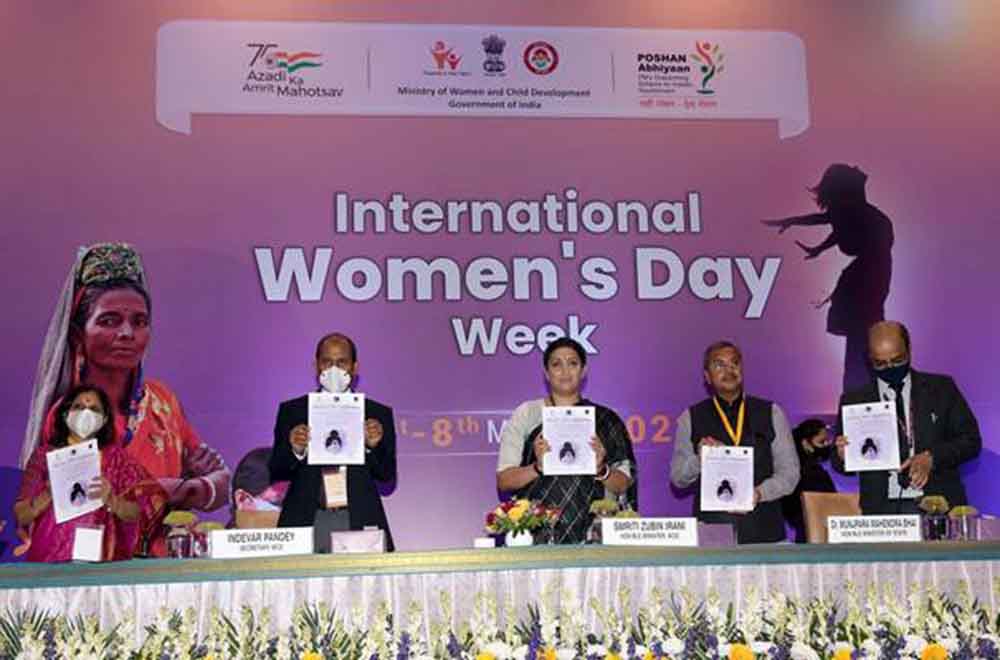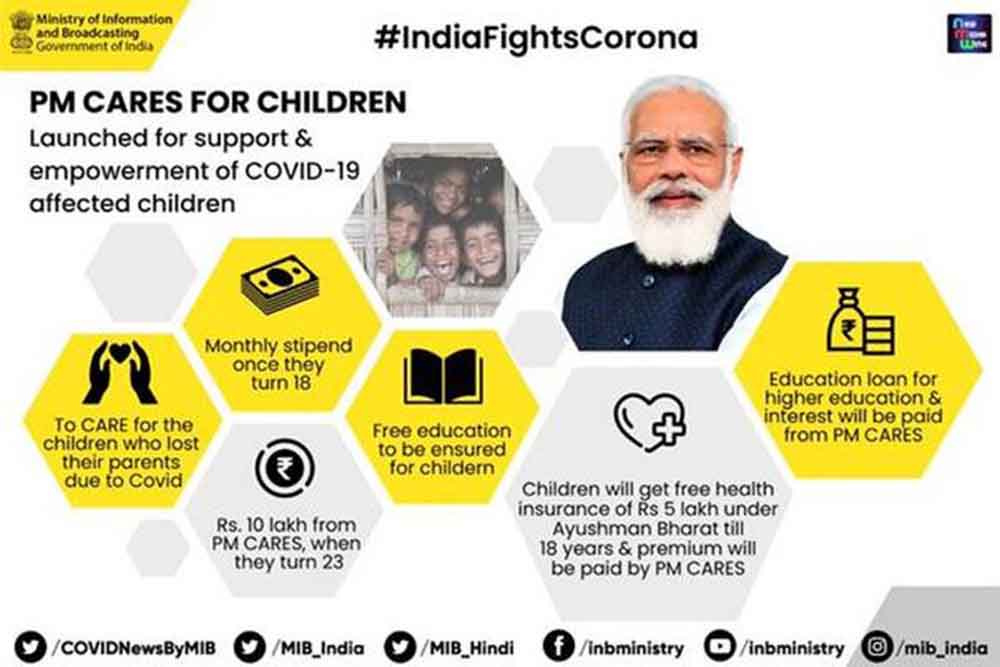Women and Children constitute 67.7 per cent of India’s population as per the 2011 census. Last year, strategic interventions for addressing malnutrition concerns and for the empowerment, development and protection of women and children were announced as a part of the union budget 2022-23. Ministry of Women and Child Development (WCD) was allocated ₹25,172.28 crore in the Union Budget 2022-23. Union Finance Minister, Nirmala Sitharaman in her Budget Speech 2022-23 said, “Nari Shakti is the harbinger of India's bright future and Empowerment and protection of women and children and ensuring their wholesome development is crucial for sustainable and equitable development of the country."
The key objective of the Women and Child Development (WCD) Ministry was to address gaps in state action for women and children and to promote inter-ministerial and inter-sectoral convergence to create gender equitable and child centred legislation, policies and programmes. Here we round up some of the schemes and missions that are crucial to the 25 year plan charted out by the Government and what is the progress so far.
For effective implementation of various schemes and programmes of the Ministry of Women and Child Development, all major schemes of the Ministry were classified under three umbrella schemes – Mission Poshan 2.0, Mission Vatsalya and Mission Shakti. The three aforementioned Missions will be implemented during the 15th Finance Commission period 2021-22 to 2025-26.
Budgets Allocated To These Schemes
The budget allocated for Saksham Anganwadi and POSHAN 2.0 (Umbrella Integrated Child Development Services- Anganwadi Services, Poshan Abhiyan, Scheme for Adolescent Girls) was ₹20,263 crore for 2022-23. ₹3,184 crore was the budget allocated for Mission Shakti (Mission for Protection and Empowerment for Women) for Financial Year 2022-23. For Mission VATSALYA (Child Protection Services and Child Welfare Services), the budget allocated is ₹1,472 crore for FY 2022-23, which is an increase of 63.5 per cent as it was ₹900 crore in 2021-22.
MISSION POSHAN 2.0

Mission POSHAN 2.0 is an Integrated Nutrition Support Program that seeks to address the challenges of malnutrition in children, adolescent girls, pregnant women and lactating mothers through a strategic shift in nutrition content and delivery and by creation of a convergent eco-system to develop and promote practices that nurture health, wellness and immunity. Mission Poshan 2.0 brings three important programmes/schemes under its ambit – Anganwadi Services, Scheme for Adolescent Girls and Poshan Abhiyaan.
The Progress So Far…
- To promote regular growth monitoring of children, 12.65 lakh growth monitoring devices, such as infantometer, stadiometer, weighing scale for mother and infant, weighing scale for child, have been procured by states and Union territories.
- To promote the nutritional status of women and children in real-time, Poshan tracker application was put on smartphones of anganwadi workers. So far, anganwadi workers have been provided with 11.22 lakh smart phones.
- As on October 31, approximately 9.84 crore beneficiaries have been on boarded. Beneficiaries on Poshan tracker were Aadhaar seeded to ensure last mile tracking and delivery of services. This led to opposition from civil rights groups who expressed concern over possibility of lack of nutrition facilities for children who did not have Aadhaar card. Following which, the Women and Child Development Ministry clarified that a child’s Aadhaar card is not mandatory for availing the benefits of nutrition scheme, and that these can be accessed using the mother’s biometric card to register on the Poshan tracker app.
- The government is exploring adding Ayush component in take-home ration of children, pregnant women and lactating women that they get from anganwadi centres to improve their nutrition level, a senior official said. The project is currently being tried out on a pilot basis in Gujarat and Karnataka and both states have given good results, the official said.
- This year, the government also decided to integrate various helplines -112, 181 and 1098 – in an effort to provide a better emergency response, another official said.
- Emergency Response Support System (ERSS) is a pan-India single number (112) for citizens in emergencies while 1098 is a toll free, phone outreach service for children.
MISSION SHAKTI

Mission Shakti is a unified citizen-centric lifecycle support for women through integrated care, safety, protection, rehabilitation and empowerment to unshackle women as they progress through various stages of their life. Mission Shakti has two sub-schemes – ‘Sambal’ and ‘Samarthya’.
The Sambal sub-scheme consists of the existing scheme of One Stop Centres (OSC), Women Helplines (181-WHL) and BetiBachaoBetiPadhao (BBBP). Besides, a new component of Nari Adalats has been added as women’s collectives to promote and facilitate alternative dispute resolution and gender justice in society and within families.
The Samarthya sub scheme is for empowerment of women, consisting of existing schemes of Ujjwala, SwadharGreh and Working Women Hostel. In addition, the National Creche Scheme for children of working mothers and the Pradhan Mantri Matru VandanaYojana (PMMVY), which have been under the Umbrella ICDS Scheme till now, are also subsumed in Samarthya.
The Progress So Far…
- As on September 30, assistance under the one-stop centres for women affected by violence and in need of assistance has been provided to over 88 lakh women.
- The ministry also launched Stree Manoraksha Project in collaboration with NIMHANS Bengaluru for psycho social training for staff and counsellors of One Stop Centres.
- The Nirbhaya fund was utilised by 70 per cent by November. From its inception till 2021-22, the total allocation under the fund has been over ₹6,000 crore, of which ₹4,200 crore has been utilised.
- Under Mission Shakti department’s banking schemes, ₹50,000cr worth of funds can now be availed by 500+ groups of women across Odisha to spearhead the state’s transformation journey.
- Uttar Pradesh will impart self-defence training in the upper primary and composite schools with the aim of ensuring safety and well-being of girls and strengthening their physical and mental self-reliance under Mission Shakti Phase Four.
MISSION VATSALYA

India is home to 472 million children up to the age of 18 years and comprise 39 per cent of the country’s population. The objective of Mission Vatsalya was to secure a healthy and happy childhood for every child in India; foster a sensitive, supportive and synchronized ecosystem for development of children; assist States/UTs in delivering the mandate of the Juvenile Justice Act 2015; achieve the SDG goals. Components under Mission Vatsalya include statutory bodies; service delivery structures; institutional care/services; non-institutional community based care; emergency outreach services; training and capacity building.
The Progress So Far…
- Under Mission Vatsalya, the Juvenile Justice Model Amendment Rules, 2022 and Adoption Regulations, 2022 were notified in September for all matters relating to child safety, empowerment and safety including issuance of adoption orders – 1) Concerns remained over high pendency of adoption cases in district courts due to new regulations but ministry said that pendency of adoption orders have come down since the rules have come into force. 2) High number of prospective adoptive parents and low availability of children legally free for adoption was another concern.
- Under the new adoption regulation waiting period was removed for those parents who desire to adopt a child having special needs and also from the immediate placement category. The immediate placement category includes children who have been referred several times to prospective adoptive parents (PAP’s) through Child Adoption Resource Information and Guidance System, but have not found a family.
- To support children who have lost both parents, single surviving parent, legal guardian or adoptive parents to the COVID-19 pandemic, the scheme for PM Cares for Children was launched last year under which a total of 4,345 children were found eligible under the scheme till this year.